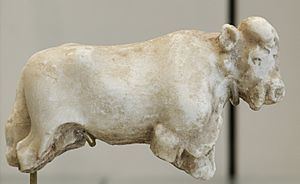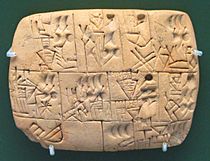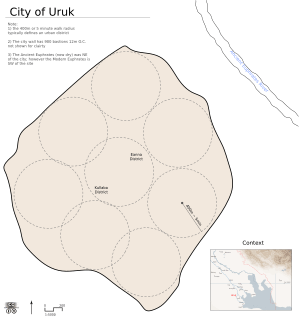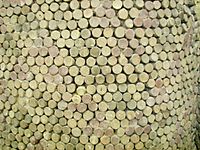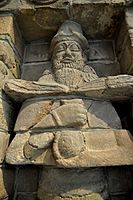Art of Uruk facts for kids
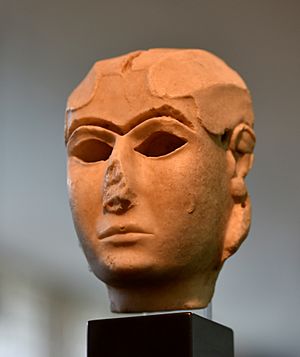
The art of Uruk comes from an ancient city called Uruk in southern Mesopotamia (modern-day Iraq). This city was very important during the Uruk period (around 4200-3000 BCE). It was one of the first true cities ever! People in Uruk created amazing sculptures, seals, pottery, and buildings. Their art shows how skilled they were and often used valuable materials. This art gives us clues about how people lived and what they believed thousands of years ago.
Contents
Sculptures: Ancient Artworks from Uruk
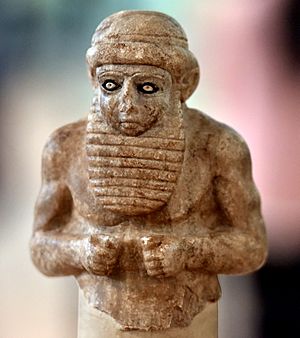
People in Uruk made small animal sculptures. These were called votive offerings. They weren't meant to be perfectly real. Instead, they captured the animal's spirit. These animal figures were left in temples. It was like a way to make an animal sacrifice last forever. Many were found at Uruk Level III (around 3000 BCE). They were likely offered to the goddess Inanna to ask for her help.
Archaeologists also found many "small finds" at Uruk. These were tiny objects, often animal figures decorated with stone. There were also special vessels. These items were used in temple rituals. When they were no longer needed, they were buried in sacred ground. Some small animal figures might have been used as amulets (lucky charms) or handles for cylinder seals.
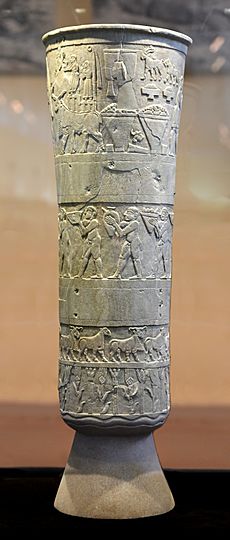
Telling Stories with Art: Uruk's Narrative Pieces
Uruk is famous for having some of the oldest examples of storytelling art. These include the Uruk Trough and the Warka Vase.
The Uruk Trough is made of limestone. It shows sheep carved in relief (sticking out from the surface). The sheep are approaching a reed hut, with lambs coming out. This scene might show how fertile the sheep flocks were. It could also show how shepherds separated ewes and lambs. This helped save the ewe's milk. The trough was probably a special object in the temple of Inanna.
The Warka Vase shows a religious celebration. It was likely part of a farming festival. This festival was connected to the goddess Inanna. The vase has four sections, called registers.
- The bottom section shows water, plants, and wheat.
- The second section shows sheep walking to the right.
- The third section shows priests walking to the left, carrying offerings.
- The top section shows a "priest-king" (partly damaged). He is approaching Inanna herself. You can tell it's Inanna by the two reed gateposts behind her temple. These gateposts are filled with offerings.
The order of these sections, from bottom to top, might show the social order of Uruk. It suggests that the city had a very organized government.
The Mask of Warka: A Famous Face
One of the most famous sculptures from Uruk is the Mask of Warka. It's also called the Lady of Warka. This marble head likely represents the goddess Inanna. It was found in the Eanna district of Uruk. It dates back to around 3100 BCE. This makes it one of the earliest known life-size sculptures.
The face of the sculpture was probably decorated with precious stones. For example, the eyebrows might have been inlaid with dark stone like lapis lazuli. The head was once part of a larger statue of the goddess. That statue was probably made of wood. Like the animal figures, this mask mixes abstract and realistic styles. It has smooth, rounded cheeks and lips, but also abstract elements like the inlaid eyebrows.
Seals: Ancient Signatures and Stories
During the Middle Uruk period, people started using cylinder seals. Before this, they used stamp seals. Uruk was the first place to use cylinder seals. This idea then spread across the entire ancient Near East. It even reached Bronze Age Greece.
Cylinder seals were like personal signatures. People used them to mark documents. They were small and shaped like cylinders. Artists carved designs into them using metal tools. When rolled onto wet clay, they left a unique impression. Broken clay seal impressions have been found with early clay writing tablets. Many recovered seals were made of stone. But people in Uruk also used metal, shell, and clay. Using stone seals as signatures shows that Uruk had a very complex system for managing things. The pictures on the seals varied. They showed kings, animals, or religious symbols of the gods.
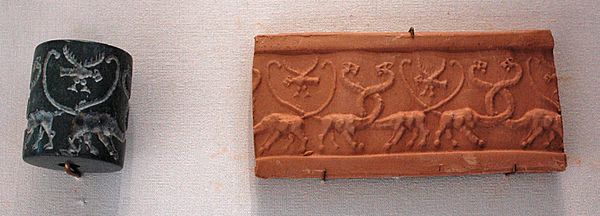
Pottery: Made for Many People
Pottery from Uruk was made in different ways: on a wheel, by hand, or molded. Potters in Uruk were very good at making many useful pots quickly. The fast potter's wheel was introduced later in the Uruk period. This made it even faster to produce pottery on a huge scale. It also made the pottery look more uniform.
Thousands of beveled rim bowls have been found. Some people think these bowls were used to measure food for families or workers. Another new invention in Uruk pottery was the ceramic ring scraper. When traders wanted to export large pots, their weight was a problem. The ring scraper allowed potters to remove extra clay before firing. This made the pots much lighter and easier to carry. Because artists could make so much pottery, it was sent to other parts of what is now modern Iraq. Uruk pottery was more popular in northern Iraq than in southern Iraq.
Writing: The First Words
Archaeologists have found what are thought to be the oldest written texts in Uruk. When excavations started in the early 1900s, archaeologists found clay tablets. These tablets had picture-like signs. They were seen as early forms of cuneiform script. This early writing, called Proto-Cuneiform, was drawn into clay with a pointed tool. Round marks meant numbers.
These earliest tablets date to around 3200 BCE. They were found among discarded materials. They were likely used to seal containers and doors. About 4000 clay tablets and fragments from this time have been found. Most of these tablets recorded business deals. They showed things like goods exchanged or food given to workers. Some even recorded how many animals were born into a herd. One text even lists 120 officials, including the city leader. It also names people who led the law, farming, and animal care. This text shows how organized Uruk's society was. It also has special terms for priests, metalworkers, and potters. Later, around 3000 BCE, other types of writing appeared. These included poetry, math, and science.
Architecture: Grand Buildings of Uruk
The biggest remaining buildings in Uruk are the temples. These ruins cover about 6 square kilometers. A city wall surrounds them. Uruk's temple designs followed older building plans. Buildings had three main parts: a central hall and smaller rooms on each side.
One of the most famous temples is the White Temple. It was named for the white plaster that covered it. This temple was for the god Anu. It was built on a platform 13 meters high. This style was a step towards the ziggurats that came later in Mesopotamian history. Unlike later temples, the White Temple did not have a central special area.
There is proof that buildings in Uruk were used for religious purposes. They were richly decorated. They also had altars for worshiping different gods. For example, in Temple C, archaeologists found pillars with cone mosaic panels. These panels date to around 3300-3000 BCE. To make them, 10-centimeter cones of baked clay or gypsum were pressed into wet plaster. They were then painted to create patterns like diamonds, triangles, and zigzags.


